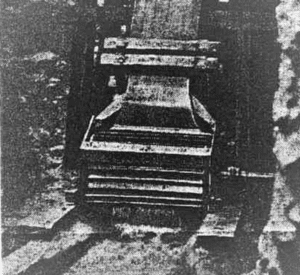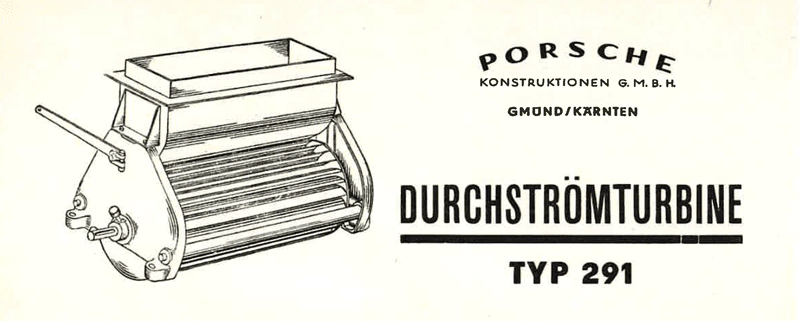Original 1949 Porsche Konstruktionen GesmbH (Gmünd) water turbine now in fahr(T)raum
In the years between 1944 and 1950, the Porsche works in Gmünd/Carinthia, which operated under the name Porsche-Konstruktionen-Ges.m.b.H., produced not only the Porsche 356 No. 1 Roadster but also designs for racing cars, tractors, cable winches, ski lifts and crossflow turbines.
The Type 291 crossflow turbine – on loan from the Porsche Automuseum in Gmünd – is currently on exhibit at fahr(T)raum. “We have been working together with the Porsche Museum in Gmünd for a long time and have a very strong and dear partner in the Pfeifhofer family,” says Jakob Iglhauser, Managing Director of the fahr(T)raum classic car museum in Mattsee near Salzburg.
 The turbine was used, inter alia, to drive sawmills, mills and agricultural machinery. It was also used to generate electricity. The advantage over the traditional water wheel was the significantly higher speed of the turbine, with which a higher output – even with a smaller water volume – could be achieved. The nozzle could be regulated by hand. The turbine was recommended for the “economic utilisation of small hydropower plants” for a power output of 4 to 20 HP for a fall height (drop) of 2.4 to 6 metres or a power output of 40 HP for a drop of 10 metres. It consists mainly of sheet steel parts welded together, the impeller runs on ball bearings. According to the original instruction handbook, maintenance is limited “to daily retightening of the lubricators provided on the bearing bodies and refilling these lubricators with grease after a longer period of operation.”
The turbine was used, inter alia, to drive sawmills, mills and agricultural machinery. It was also used to generate electricity. The advantage over the traditional water wheel was the significantly higher speed of the turbine, with which a higher output – even with a smaller water volume – could be achieved. The nozzle could be regulated by hand. The turbine was recommended for the “economic utilisation of small hydropower plants” for a power output of 4 to 20 HP for a fall height (drop) of 2.4 to 6 metres or a power output of 40 HP for a drop of 10 metres. It consists mainly of sheet steel parts welded together, the impeller runs on ball bearings. According to the original instruction handbook, maintenance is limited “to daily retightening of the lubricators provided on the bearing bodies and refilling these lubricators with grease after a longer period of operation.”
The turbine was produced in two types – type 291/1 (490 kg, max. height 760 mm, max. length 1250 mm) and type 291/2 (390 kg, max. height 740 mm, max. length 750 mm). The purchase and installation of the turbine was affordable even for economically weak mining operations.
Originally, the crossflow turbine was invented as early as 1903 by Anthony George Michell in Melbourne. Improvements were first made by Professor Donat Bánki from Budapest and later by Ing. Erwin Sonneck.
How does the water in the crossflow turbine work? The answer to this question, as well as further technical details on how the turbine works, can be found in the current classic car exhibition at Ferdinand Porsche’s worlds of experience fahr(T)raum !







Hard times: Porsche develops winches for mountain farmers after the war
/v Geschichte, Motoren, Uncategorized @csNEW at fahr(T)raum: a Type 335 winch from 1946 During the Second World War, Ferdinand Porsche had to move his „Dr. Ing. h.c. F. Porsche GmbH, Design and Consultancy for Motors and Vehicles“ company, founded in 1931 and based in Kronenstraße 24, Stuttgart, due to Allied bombing raids. He relocated his design office classified as […]
The first traffic rules – displacement and adaptation caused by the automobile
/v Geschichte, Uncategorized @csAround 1900, as was the case for millennia, the horse still dominated in the transport of people and loads. Only the utmost upper class could afford private cars. In 1914, people were already crying „Vienna is choking with traffic“, although at that time there were only about 4,000 cars in Austria´s capital. Today, in Vienna […]
3. Classic motorcycle special exhibition – sidecars from 1926
/v Geschichte, Sonderausstellung, Sonstige Fahrzeuge, Uncategorized @csFor the third year running, the classic motorcycle special exhibition will kick off at fahr(T)raum Mattsee from 1 October – this year under the title „Right or Left …. around the world“. A total of 15 historic motorcycle and sidecar rigs from 1925-1960 are on display including, inter alia, a Royal Enfield 1000 with sports […]